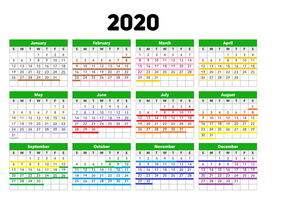Lyteran calendar
The Lyteran Calendar (also known as 14 Month Calendar) is a calendar system Derived from the Gregorian Calendar with the difference being the year measured as year 0 (508 BC), The date of new years (21 June) and with 14 months instead of 12. The system was adopted to focus more time on the warm, summer months, and to have a unique system. (ex. 2024 AD is 2531-2532 AAC)
Months
There are fourteen months, most have 28 or 27 days, but two months (three in leap years) break this trend. Each month is named after a Greek God, with days of the week remaining the same.
Lyteran Months
| Month | Godly Name | Days | Gregorian Equivalent | Abbreviation |
|---|---|---|---|---|
| Heraion | Hera | 28 | June 21 - July 18 | Her |
| Poseidon | Poseidon | 27 | July 19 - Aug 14 | Pos |
| Zeusion | Zeus | 28 | Aug 15 - Sep 11 | Zeu |
| Demetion | Demeter | 27 | Sep 12 - Oct 8 | Dem |
| Hephaestion | Hephaestus | 28 | Oct 9 - Nov 5 | Hep |
| Artemision | Artemis | 27 | Nov 6 - Dec 2 | Art |
| Hadeion | Hades | 28 | Dec 3 - Dec 30 | Had |
| Aphroditeon | Aphrodite | 27 | Dec 31 - Jan 26 | Aph |
| Apollion | Apollo | 28 | Jan 27 - Feb 23 | Apo |
| Hermeion | Hermes | 27 (28 in Leap Years) | Feb 24 - Mar 22 | Hem |
| Athenion | Athena | 28 | Mar 23 - Apr 19 | Ath |
| Dionysion | Dionysus | 27 | Apr 20 - May 16 | Dio |
| Aresion | Ares | 28 | May 17 - Jun 13 | Are |
| Hestiaon | Hestia | 7 | Jun 14 - Jun 20 | Hes |

Layout
Date layouts for the Lytera Calendar use the European (dd/mm/yyyy) formatting followed by either the abbreviation PAC or AAC depending on if before or after 508 BC, considered 1 AAC.
Historic Date Converter
- 3500 BC - Invention of the Wheel in Mesopotamia - 2992 – 2991 PAC
- 1250 BC - Destruction of Troy VI - 742 – 741 PAC
- 509 BC - Year Before Classical Athens was Founded - 1 PAC - 0 AAC
- 508 BC - Year Classical Athens Was Founded - 0-1 AAC
- 476 AD - Fall of the Western Roman Empire - 983–984 AAC (Sep 4 - Zeu 21 984)
- 1066 AD - Battle of Hastings - 1573–1574 AAC (Oct 14 - Hep 6 1574)
- 1453 AD - Fall of Constantinople - 1960–1961 AAC (May 29 - Are 13 1960)
- 1776 AD - US Declaration of Independence - 2283–2284 AAC (Jul 4 - Her 14 2284)
- 1789 AD - French Revolution - 2296–2297 AAC (May 5 - Dio 16 2296)
- 1815 AD - Battle of Waterloo - 2322–2323 AAC (Jun 18 - Hes 5 2322)
- 1917 AD - October Revolution - 2424–2425 AAC (Nov 6 - Art 1 2425)
- 1945 AD - End of WW2 - 2452–2453 AAC (Sep 2 - Zeu 19 2453)
- 1961 AD - Yuri Gagarin is the first in space - 2468–2469 AAC (Apr 12 - Ath 21 2468)
- 1991 AD - Cold War Ends - 2498–2499 AAC (Dec 26 - Had 24 2499)
- 2002 AD - Birth of Amelia I - 2509–2510 AAC (Oct 3 - Dem 22 2510)
- 2010 AD - Foundation of Lytera - 2517–2518 AAC
- 2017 AD - Lyteran War of the Crown - 2524–2525 AAC (Aug 21 - Zeu 7 2525)
- 2021 AD - LUNA goes to the Moon - 2528–2529 AAC (July - Heraion/Poseidon)
- Fiction Past This Point
- 2069 AD - Armstrong Outpost on the Moon - 2576–2577 AAC
- 2103 AD - Lowell City first settlement on Mars - 2610–2611 AAC
- 2157 AD - Mass Effect's First Contact War - 2664–2665 AAC
- 2819 AD - Mass Effect Andromeda - 3326–3327 AAC
- Fiction Ended
- 2999 AD - The Longplayer composition is set to finish - 4506–4507 AAC
- Speculation
- 252020 AD - Loihi becomes an island - 252527–252528 AAC
- 65000002020 AD - The Moon is expected to collide with Earth - 65000002527–65000002528 AAC
- 292277026596 AD - Numeric overflow in system time for 64-bit Unix systems. - 292277027103–292277027104 AAC
Usage
Users of the Lyteran Calendar currently only include micronations with the most widespread user being the Kingdom of Lytera.
Users
- Kingdom of Lytera - Official calendar of the nation, held in equal standing the Gregorian Calendar.
- Principality of Pelkesa - Official calendar of the nation, held in equal standing the Gregorian Calendar..